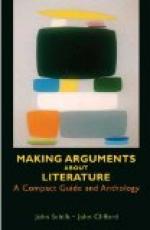Remains of thousands of species of animals and plants, as perfectly recognizable as those of existing forms of life which you meet with in museums, or as the shells which you pick up upon the seabeach, have been embedded in the ancient sands, or muds, or limestones, just as they are being embedded now, in sandy, or clayey, or calcareous subaqueous deposits. They furnish us with a record, the general nature of which cannot be misinterpreted, of the kinds of things that have lived upon thy surface of the earth during the time that is registered by this great thickness of stratified rocks. But even a superficial study of these fossils shows us that the animals and plants which live at the present time have had only a temporary duration; for the remains of such modern forms of life are met with, for the most part, only in the uppermost or latest tertiaries, and their number rapidly diminishes in the lower deposits of that epoch. In the older tertiaries, the places of existing animals and plants are taken by other forms, as numerous and diversified as those which live now in the same localities, but more or less different from them; in the Mesozoic rocks, these are replaced by others yet more divergent from modern types; and in the Paleozoic formations the contrast is still more marked. Thus the circumstantial evidence absolutely negatives the conception of the eternity of the present condition of things. We can say with certainly that the present condition of things has existed for a comparatively short period; and that, so far as animal and vegetable nature are concerned, it has been preceded by a different condition. We can pursue this evidence until we reach the lowest of the stratified rocks, in which we lose the indications of life altogether. The hypothesis of the eternity of the present state of nature may therefore be put out of court.
We now come to what I will term Milton’s hypothesis—the hypothesis that the present condition of things has endured for a comparatively short time; and, at the commencement of that time, came into existence within the course of six days. I doubt not that it may have excited some surprise in your minds that I should have spoken of this as Milton’s hypothesis, rather than that I should have chosen the terms which are more customary, such as “the doctrine of creation,” or the “Biblical doctrine,” or “the doctrine of Moses,” all of which denominations, as applied to the hypothesis to which I have just referred, are certainly much more familiar to you than the title of the Miltonic hypothesis. But I have had what I cannot but think are very weighty reasons for taking the course which T have pursued. In the first place, I have discarded the title of the doctrine of “creation,” because my present business is not with the question why the objects which constitute Nature came into existence, but when they came into existence, and in what order. This is as strictly a historical question as the question




